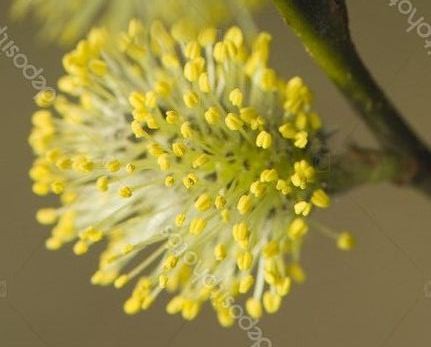Goat willow
(Salix cinerea)

Description
Salix caprea, known as goat willow, pussy willow or great sallow, is a common species of willow native to Europe and western and central Asia. It is a deciduous shrub or small tree, reaching a height of 8–10 m (26–33 ft), rarely to 13 m. The leaves are 3–12 cm long and from 2–8 cm wide, broader than most other willows. The flowers are soft silky, and silvery 3-7-cm-long catkins are produced in early spring before the new leaves appear; the male and female catkins are on different plants (dioecious). The male catkins mature yellow at pollen release, the female catkins mature pale green. The fruit is a small capsule 5–10 mm long containing numerous minute seeds embedded in fine, cottony hairs. The seeds are very small (about 0.2 mm) with the fine hairs aiding dispersal; they require bare soil to germinate. The two varieties are: S. c. var. caprea - lowland regions throughout the range, leaves thinly hairy above, densely hairy below, 5–12 cm long, stipules persistent until autumn S. c. var. sphacelata (Sm.) Wahlenb. (syn. S. caprea var. coaetanea Hartm.; S. coaetanea (Hartm.) Floderus) - high altitudes in the mountains of central and northern Europe (Alps, Carpathians, Scotland, Scandinavia), leaves densely silky-hairy on both sides, 3–7 cm long, stipules early deciduous. In western Norway there are trees of S. c. var 'Sphacelata' that are 18-20 meters tall and have mostly single trunks. The Latin specific epithet caprea means "goat". This, and the common name goat willow, probably derive from the first known illustration of the species in Hieronymus Bock's 1546 Herbal, where the plant is shown being browsed by a goat. The species was historically also widely used as a browse for goats, to which Bock's illustration may refer. S. caprea occurs both in wet/damp environments, such as riverbanks and lake shores, and in drier sites, wherever bare soil becomes available due to ground disturbance. Hybrids with several other willow species are common, notably with Salix cinerea (S. reichardtii), Salix aurita (S. multinervis), Salix viminalis (S. smithiana), and Salix purpurea (S. sordida). Populations of S. caprea often show hybrid introgression.
Taxonomic tree:







